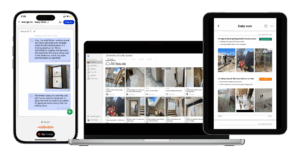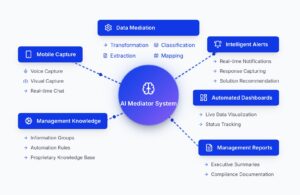It is a narrative familiar in the construction sector. An infrastructure project gradually succumbs to a cascade of delays and budget overruns. Annie Liang, Co-Founder and Chief Executive Officer at Billie Onsite reckons she has the answer and, with the help of AI, is disarmingly simple to implement

This industry-specific challenge directly impacts New Zealand’s broader economic story. Studies have long shown New Zealand’s construction productivity lags behind that of Australia and our overall economy is one of the least efficient in the OECD. Improving the knowledge workflow in construction is a critical lever for enhancing our national economic performance.
The critical question in construction and civil contracting projects is no longer if a project will be derailed, but why this pattern continues to repeat itself.
The answer lies in a large part by taking charge of the divide between site and office. Artificial Intelligence (AI) is the catalyst to finally bridge the chasm between onsite and office efficiency and transform how New Zealand builds its future, according to Billie Onsite’s Annie Liang.
The disconnect between site and office directly impacts the construction sector’s “knowledge workers”, budgets and timelines. The technologies of the past have proven incapable of fixing this fundamental problem.
“The time for incremental change has passed. For construction leaders in New Zealand, it is imperative to look beyond familiar solutions and make a strategic commitment to AI-powered workflows that unite the field and the office, says Liang.
“For an industry constrained by ‘scale inefficiency’ as identified in New Zealand’s case, AI offers a powerful way for firms of all sizes to become more efficient and data-driven.
“We are inadvertently turning our expert problem-solvers into administrative data processors.
Our highly skilled engineers, project managers, and supervisors — the knowledge workers — are the central nervous system of these projects, yet their productivity is being constrained by disconnected, outdated workflows,” says Liang.
Billie Onsite is a voice-visual AI system that allows professionals across the industry to document, verify and collaborate by voice commands and visual captures during site inspections, while intelligently processing follow-up actions and reporting for all relevant stakeholders.
“It instantly categorises and summarises voice and visual data, automates and generates reports and verifies inspection findings against codes and standards via one centralised dashboard,” says Liang.

Site and office divide
The current daily reality for a project engineer is a fractured existence between two distinct worlds. On site, they are firefighters, confronting immediate, tangible issues that demand swift, informed decisions — be it unexpected ground conditions, a subcontractor’s deviation from plans or a critical safety incident. This environment is dynamic, visual and context-rich.
“Upon returning to the office, the role shifts from problem-solver to administrator. They are mired in the work of transcribing handwritten notes, uploading photos and attempting to convey the complex nuance of site conditions through fragmented emails and spreadsheets. The constant travel between site and office is less about solving engineering problems and more about reconciling two different versions of reality,” says Liang.
“We are paying our most experienced professionals to spend over a third of their time on low-value clerical work — up to five hours a week searching for project data and up to eight hours doing manual entry from the field.
“This is at the core of our productivity challenge,” says Liang. “It fuels expert burnout, compromises decision-making and fosters a culture where paperwork takes precedence over problem-solving.
Data fragmentation
This dysfunction is rooted in data fragmentation. The median construction business in the Asia-Pacific region now uses 11 different software platforms. These information silos sever the essential link between real-world context on the site and structured data in the office, according to Liang.
“This disconnect manifests itself in tangible project delays. A landmark industry study indicates that 29 percent of all tasks that exceed their expected timelines are a direct result of poor communication,” Liang says.
Traditional methods like emails, phone calls, and paper forms are insufficient for conveying complex, visual site information.
“A photo of a foundation crack loses its urgency when buried in an email chain. A verbal report of a safety hazard loses its context when it isn’t immediately linked to a specific location, time, and set of conditions,” notes Liang
“In New Zealand’s diverse worksites, this problem is compounded by cultural and language differences. The indirect communication style common among Kiwis can be misinterpreted by migrant workers, leading to misunderstandings that create rework and safety risks.
“When foundational communication systems are already strained, these secondary barriers become even more significant,” she says.
Cost of inefficiency
The financial toll of this systemic inefficiency is staggering. Reports from 2023 reveal that one in eight working hours is spent on rework across Australia and New Zealand — heavily due to preventable mistakes, driven by poor data and communication.
Beyond the balance sheet lies a significant cost in human capital. We are at risk of squandering our most valuable asset — human expertise. Research indicates that project managers lose a significant amount of time to non-productive, administrative activities.
What’s wrong
An Autodesk report reveals that 54 percent of technology purchases are made to suit the needs of the office, compared to only 36 percent for the field.
Technological solutions have thus consistently missed the mark for a clear reason: an historical misalignment in investment focus. The predictable consequence is that expensive, “clunky” software is pushed onto site teams.
“This technology is fundamentally unfit for their workflows, leading to poor adoption and a reversion to the familiar inefficiencies of pen and paper,” claims Liang.
“Simply providing tablets and smartphones to site staff is not a complete strategy. While an estimated 70 percent of construction professionals are now equipped with mobile devices, reports show that as few as between eight and 20 percent consistently use these devices for genuine collaboration and data access.
“Digital checklists and basic cloud storage are not transformative. They are merely digital versions of their paper-based predecessors. They fail to solve the core problem of data synthesis and contextual communication, instead digitising the act of data entry without bridging the gap between site and office,” says Liang.
The role of AI
With past tools falling short, the industry required a breakthrough. AI is fundamentally different because it represents a move beyond simple data storage and into the realm of intelligent synthesis.
AI’s unique potential lies in its ability to:
- Capture context: AI analyses unstructured data — site photos, dictated voice notes, daily logs — to understand the meaning and intent behind the information.
- Automate reporting: It automatically generates progress reports, identifies risks by detecting deviations, and flags issues, freeing up engineers to manage, not administrate.
- Provide a single source of truth: AI creates an intelligent, searchable “digital twin” of site knowledge. A move to such a uniform data environment could save each worker up to 10.5 hours per week.
How it works
An AI-powered system transforms this workflow. An engineer spots a potential issue onsite, takes a photo with their phone and dictates a two-sentence observation. The system instantly logs the issue, identifies its location, cross-references project plans and technical requirements, notifies stakeholders and logs the interaction in a searchable database. A task that once took hours can now be completed in seconds.
This is no longer a distant vision. The data shows we are at a tipping point. According to a joint Deloitte-Autodesk report, AI adoption in the sector grew from 26 percent in 2023 to 37 percent in 2024. In Australia, AI is the most anticipated technological advancement, with 30 percent of companies already using it and another 33 percent planning to use it.
 Annie Liang developed unique perspectives in construction technology when she led research for an innovative prefabrication system for a project in Auckland. Her first-hand insights into the challenges of AS/NZS compliance, quality control and stakeholder communication drove her to create Billie Onsite. She spent six years at financial services company, UBS AG, before returning to her passion for building and construction. https://www.billieonsite.com/
Annie Liang developed unique perspectives in construction technology when she led research for an innovative prefabrication system for a project in Auckland. Her first-hand insights into the challenges of AS/NZS compliance, quality control and stakeholder communication drove her to create Billie Onsite. She spent six years at financial services company, UBS AG, before returning to her passion for building and construction. https://www.billieonsite.com/
